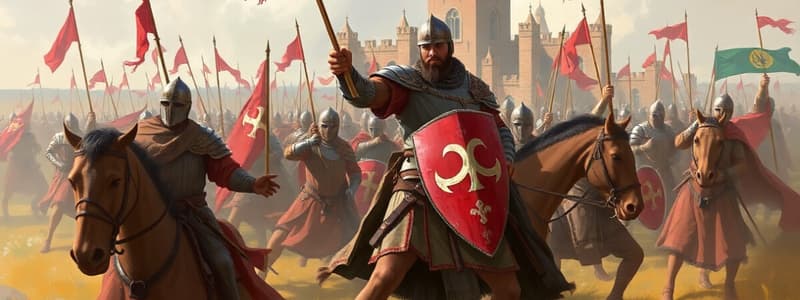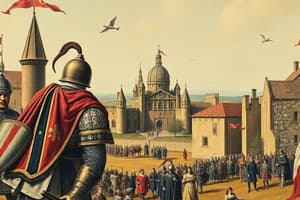Podcast
Questions and Answers
What key outcome resulted from the Norman conquest of England?
What key outcome resulted from the Norman conquest of England?
- Replacement of the Anglo-Saxon aristocracy with a Norman ruling class. (correct)
- Reinforcement of Anglo-Saxon legal traditions.
- Preservation of English as the sole language of the court and administration.
- The widespread adoption of Norse religious practices. 123
The Bayeux Tapestry primarily commemorates what event?
The Bayeux Tapestry primarily commemorates what event?
- The construction of the Tower of London.
- The events leading up to the Norman invasion and the Battle of Hastings. (correct)
- The coronation of Harold Godwinson.
- The signing of the Magna Carta.
Which societal system was introduced to England following the Battle of Hastings?
Which societal system was introduced to England following the Battle of Hastings?
- Communal system
- Barter system
- Feudal system (correct)
- Tributary system
How did the Norman conquest MOST impact the English language?
How did the Norman conquest MOST impact the English language?
Imagine an alternate scenario where Harold Godwinson decisively wins the Battle of Hastings; which outcome is LEAST probable?
Imagine an alternate scenario where Harold Godwinson decisively wins the Battle of Hastings; which outcome is LEAST probable?
When did the Battle of Hastings occur?
When did the Battle of Hastings occur?
Who led the English army at the Battle of Hastings?
Who led the English army at the Battle of Hastings?
What was the primary reason William of Normandy claimed the English throne?
What was the primary reason William of Normandy claimed the English throne?
Where exactly was the Battle of Hastings fought?
Where exactly was the Battle of Hastings fought?
What critical advantage did William's army possess over Harold's forces at Hastings?
What critical advantage did William's army possess over Harold's forces at Hastings?
What key tactic did William's knights employ to disrupt the English shield wall?
What key tactic did William's knights employ to disrupt the English shield wall?
Analyze the strategic implications if Harold Godwinson had not needed to fight Harald Hardrada just weeks before facing William. How might English fortunes have differed at Hastings?
Analyze the strategic implications if Harold Godwinson had not needed to fight Harald Hardrada just weeks before facing William. How might English fortunes have differed at Hastings?
Suppose a contemporary military analyst could advise either Harold or William before the battle. What single piece of advice, unavailable at the time, would have most drastically altered one side's chances of victory, considering the technological and informational constraints?
Suppose a contemporary military analyst could advise either Harold or William before the battle. What single piece of advice, unavailable at the time, would have most drastically altered one side's chances of victory, considering the technological and informational constraints?
Flashcards
Harold's Death Impact
Harold's Death Impact
Harold Godwinson's death led to the collapse of English resistance.
Battle of Hastings Significance
Battle of Hastings Significance
Marks a turning point, leading to Norman rule and societal changes.
Norman Aristocracy
Norman Aristocracy
Replaced Anglo-Saxon leaders with a French-speaking elite. The language of power shifted.
Language post-1066
Language post-1066
Signup and view all the flashcards
Feudal System
Feudal System
Signup and view all the flashcards
Battle of Hastings Date
Battle of Hastings Date
Signup and view all the flashcards
Hastings Combatants
Hastings Combatants
Signup and view all the flashcards
Battle of Hastings Result
Battle of Hastings Result
Signup and view all the flashcards
William's Claim
William's Claim
Signup and view all the flashcards
William's Preparations
William's Preparations
Signup and view all the flashcards
Harold's Strategy
Harold's Strategy
Signup and view all the flashcards
Battle Location Advantage
Battle Location Advantage
Signup and view all the flashcards
English Shield Wall
English Shield Wall
Signup and view all the flashcards
Study Notes
- The Battle of Hastings occurred on October 14, 1066.
- The Norman-French army, led by William, Duke of Normandy, fought against the English army, led by King Harold Godwinson.
- The battle was a decisive Norman victory.
- The victory led to the conquest of England.
- William the Conqueror became the new King of England, altering English history.
Background
- After King Edward the Confessor died without an heir in January 1066, multiple people claimed the English throne.
- Harold Godwinson was crowned king soon after Edward's death; William of Normandy also claimed the throne.
- William claimed Edward promised him the throne and Harold swore an oath to support his claim.
- Harald Hardrada, King of Norway, also claimed the English throne through a succession agreement with a previous king.
Preparations
- William spent months gathering troops and resources in Normandy for his invasion.
- William's army included Norman knights and mercenaries from Brittany, Flanders, and other regions of France.
- Harold Godwinson faced a threat from Harald Hardrada, who landed in Northern England.
- On September 25, 1066, Harold defeated Hardrada at the Battle of Stamford Bridge, weeks before Hastings.
- Harold's army marched south to confront William after defeating Hardrada.
Battle Location
- The battle occurred at Senlac Hill, about 6 miles (9.7 km) northwest of Hastings.
- William chose the location for its tactical advantage.
- English forces occupied the hill's crest, forming a shield wall.
Forces
- William's army was estimated to have 7,000 to 8,000 troops.
- The army comprised heavily armored knights, infantry, and archers.
- Harold's army was about the same size, consisting mostly of foot soldiers armed with axes, swords, and spears.
- The English lacked the archers and cavalry numbers that the Normans had.
Course of Battle
- The battle began with Norman archers firing uphill at the English shield wall.
- Infantry and cavalry assaults followed the archers.
- The English shield wall initially held firm, repelling Norman attacks.
- William's knights used direct charges and feigned retreats to break the English lines.
- Rumors spread that William died during the battle, but he removed his helmet to prove he was still alive.
- The English shield wall weakened late in the day due to fatigue and casualties.
- Harold Godwinson was reportedly killed late in the battle, possibly by an arrow to the eye, as shown in the Bayeux Tapestry.
- After Harold's death, English resistance collapsed, and the Normans won.
Significance
- The Battle of Hastings was a turning point in English history.
- William's victory led to the Norman conquest of England.
- The Norman conquest brought significant changes to English government, law, language, and culture.
- The Anglo-Saxon aristocracy was replaced by a new Norman ruling class.
- French became the language of the court and administration, influencing the development of the English language.
- The feudal system was introduced to England, which altered land ownership and social structure.
- The battle is commemorated by the Bayeux Tapestry, which depicts the events leading up to the invasion and the battle itself.
Studying That Suits You
Use AI to generate personalized quizzes and flashcards to suit your learning preferences.


